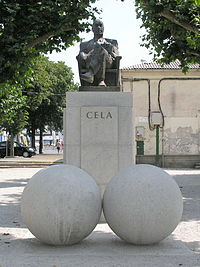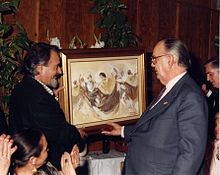Camilo José Cela
Camilo José Cela | |
|---|---|
 | |
| Born | Camilo José Cela y Trulock 11 May 1916 Padrón, Galicia, Spain |
| Died | 17 January 2002 (aged 85) Madrid, Spain |
| Resting place | Iria Flavia cemetery |
| Occupation | Novelist, short story writer, essayist |
| Language | Spanish |
| Nationality | Spanish |
| Literary movement | Generation of '36 |
| Notable works | The Family of Pascual Duarte, The Hive |
| Notable awards | Nobel Prize in Literature 1989 |
| Spouse | María del Rosario Conde Picavea (m. 1944-div. 1990) Marina Concepción Castaño López (m. 1991-2002) (his death) |
| Children | Camilo José Cela Conde |
Camilo José Cela y Trulock, 1st Marquis of Iria Flavia (Spanish: [kaˈmilo xoˈse ˈθela]; 11 May 1916 – 17 January 2002) was a Spanish novelist, short story writer and essayist associated with the Generation of '36 movement.
He was awarded the 1989 Nobel Prize in Literature "for a rich and intensive prose, which with restrained compassion forms a challenging vision of man's vulnerability".[1]
Childhood and early career
Camilo José Cela was born in the rural parish of Iria Flavia, in Padrón, Province of A Coruña, Spain, on 11 May 1916.[2] He was the oldest child of nine.[3] His father, Camilo Crisanto Cela y Fernández, was Galician and his mother, Camila Emanuela Trulock y Bertorini, while also Galician, was of English and Italian ancestry. The family was upper-middle-class and Cela described his childhood as being "so happy it was hard to grow up."[3]
From 1921 to 1925, he lived with his family in Vigo where they ended up leaving in order to go and live in Madrid. It was here Cela was able to study at a Piarist school. In 1931 he was diagnosed with tuberculosis and admitted to the sanatorium of Guadarrama where he took advantage of his free time to work on his novel, Pabellón de reposo. While recovering from the illness he began intensively reading works by José Ortega y Gasset and Antonio de Solís y Ribadeneyra.
The Spanish Civil War broke out in 1936 when Cela was 20 years old and just recovering from his illness. His political leanings were conservative and he was able to escape to the rebel zone and enlisted himself as a soldier but was wounded and hospitalized in Logroño.
Career
The civil war ended in 1939 and Cela demonstrated his indecisiveness towards his university studies and ended up working in a bureau of textile industries. It was here where he began to write what would become his first novel, [La familia de Pascual Duarte] Error: {{Lang}}: text has italic markup (help) (The Family of Pascual Duarte), which was finally published when he was 26, in 1942. Pascual Duarte has trouble finding validity in conventional morality and commits a number of crimes, including murders, for which he feels nothing. In this sense he is similar to Meursault in Albert Camus's novel The Stranger. This novel is also of particular importance as it played a large part in shaping the direction of the post-World War II Spanish novel.

Cela's best known work came during a period where his work had been banned by Spanish censors. Such work includes [La colmena] Error: {{Lang}}: text has italic markup (help) (The Hive) which was published in 1950,[4] featuring more than 300 characters and a style showing the influence of both Spanish realism (best exemplified by Miguel de Cervantes and Benito Pérez Galdós) and contemporary English and French-language authors, such as Joyce, Dos Passos, and Sartre. Cela's typical style—a sarcastic, often grotesque, form of realism—is exemplified in [La colmena] Error: {{Lang}}: text has italic markup (help).
From the late 1960s, with the publication of [San Camilo 1936] Error: {{Lang}}: text has italic markup (help), Cela's work became increasingly experimental. In 1988, for example, he wrote [Cristo versus Arizona] Error: {{Lang}}: text has italic markup (help) (Christ versus Arizona), which tells the story of the Gunfight at the O.K. Corral in a single sentence that is more than a hundred pages long.
Legacy

On 26 May 1957 Cela was appointed a member of the Royal Spanish Academy and given Seat Q. He was appointed Royal Senator in the Constituent Cortes, where he exerted some influence in the wording of the Spanish Constitution of 1978. In 1987, he was awarded the Prince of Asturias Award for Literature.
He was awarded the illustrious Nobel Prize in Literature in 1989 "for a rich and intensive prose, which with restrained compassion forms a challenging vision of man's vulnerability".[5]
In 1994, he was awarded the Premio Planeta,[6] although some question the objectivity of the awards, and winners on occasion have refused to accept it.[citation needed] Two years later, in recognition of his contributions to literature, Cela was ennobled on 17 May 1996 by King Juan Carlos I, who gave Cela the hereditary title of Marquis of Iria Flavia in the nobility of Spain. On his death the title passed to his son Camilo José Cela Conde.
Controversies
The Hive was first published in Argentina, as Franco's Roman Catholic Church-affiliated government banned it because of the perceived immorality of its content referencing erotic themes. This meant that his name could no longer appear in the printed media.[7] Nevertheless, Cela remained loyal to the Franco regime, even working as an informer for the Spanish secret police by reporting on the activities of dissident groups.[8][9]
In his later years he became known for his scandalous outbursts; in an interview with Mercedes Milá for Spanish state television he boasted of his ability to absorb litres of water via his anus while offering to demonstrate.[10] He had already scandalized Spanish society with his [Diccionario secreto] Error: {{Lang}}: text has italic markup (help) (Secret Dictionary, 1969–1971), a dictionary of slang and taboo words.
He described the Spanish Cervantes Prize as being "covered with shit"[11] and was later, ironically, awarded the prize in 1995.
In 1998, he expressed discomfort towards the presence of homosexual groups at the commemoration of Federico Garcia Lorca's centenary, stating that, "For me, I would prefer a more straight forward and less anecdotal commemoration without the support of gay groups. I have nothing against gays, I just do not take it up the ass".[12]
Death
Cela died from heart disease on 17 January 2002 at the Hospital Centro in Madrid, aged 85. He was buried in his hometown at the parish cemetery of Santa María de Adina.[13]
His will was contested because he favoured his widow and second younger wife, Marina Castaño, over his son Camilo José Cela Conde from a previous marriage.[14]
Ancestors
| Family of Camilo José Cela | |||||||||||||||||||||||||||||||||||||||||||||||||||||||||||||||||||||||||||||||||||||||||||||||||||||||||||||||||||||||||||||||||||||||||||||||||||||||||||||||||||||||||||||||||||||||||||||||||||||||||||||||||||||||||||||||||||||||||||||||||||||||||||||||||||||||||||||||||||||||||
|---|---|---|---|---|---|---|---|---|---|---|---|---|---|---|---|---|---|---|---|---|---|---|---|---|---|---|---|---|---|---|---|---|---|---|---|---|---|---|---|---|---|---|---|---|---|---|---|---|---|---|---|---|---|---|---|---|---|---|---|---|---|---|---|---|---|---|---|---|---|---|---|---|---|---|---|---|---|---|---|---|---|---|---|---|---|---|---|---|---|---|---|---|---|---|---|---|---|---|---|---|---|---|---|---|---|---|---|---|---|---|---|---|---|---|---|---|---|---|---|---|---|---|---|---|---|---|---|---|---|---|---|---|---|---|---|---|---|---|---|---|---|---|---|---|---|---|---|---|---|---|---|---|---|---|---|---|---|---|---|---|---|---|---|---|---|---|---|---|---|---|---|---|---|---|---|---|---|---|---|---|---|---|---|---|---|---|---|---|---|---|---|---|---|---|---|---|---|---|---|---|---|---|---|---|---|---|---|---|---|---|---|---|---|---|---|---|---|---|---|---|---|---|---|---|---|---|---|---|---|---|---|---|---|---|---|---|---|---|---|---|---|---|---|---|---|---|---|---|---|---|---|---|---|---|---|---|---|---|---|---|---|---|---|---|---|---|---|---|---|---|---|---|---|---|---|---|---|---|---|---|---|
| |||||||||||||||||||||||||||||||||||||||||||||||||||||||||||||||||||||||||||||||||||||||||||||||||||||||||||||||||||||||||||||||||||||||||||||||||||||||||||||||||||||||||||||||||||||||||||||||||||||||||||||||||||||||||||||||||||||||||||||||||||||||||||||||||||||||||||||||||||||||||
See also
References
- ^ "Nobel Prize in Literature 1989". Nobel Foundation. Retrieved 2008-10-17.
- ^ "Camilo José Cela - Biographical". www.nobelprize.org. Retrieved 2016-07-13.
- ^ a b Eaude, Michael (2002-01-18). "Obituary: Camilo José Cela". the Guardian. Retrieved 2016-07-13.
- ^ Formats and Editions of La colmena WorldCat.org Retrieved 2016-01-06.
- ^ Nobel prize citation
- ^ Camilo José Cela
- ^ http://www.theparisreview.org/interviews/1396/the-art-of-fiction-no-145-camilo-jos-cela
- ^ [1]
- ^ Unearthing Franco's Legacy, p.15 University of Notre Dame Press, ISBN 0-268-03268-8.
- ^ [Todos los títulos fueron suyos Error: {{Lang}}: text has italic markup (help)], Luis Ventoso, [La Voz de Galicia] Error: {{Lang}}: text has italic markup (help), 18 January 2002.
- ^ [La leyenda del gran provocador Error: {{Lang}}: text has italic markup (help)], Ángel Vivas, El Mundo, 18 January 2002.
- ^ Artículo homófobo sobre Lorca
- ^ BBC obituary
- ^ Viuda e hijo, enfrentados por su herencia
External links
- Camilo José Cela Foundation
- Valerie Miles (Summer 1996). "Camilo José Cela, The Art of Fiction No. 145". Paris Review.
- BBC obituary
- Biography of Camilo José Cela
- Photos
- The Nobel Foundation has a site on him, including speeches, biography and bibliography.
- Genealogy of Cela Family
- 1916 births
- 2002 deaths
- People from O Sar
- Galician writers
- Nobel laureates in Literature
- Premio Cervantes winners
- Spanish Nobel laureates
- Margraves of Iria Flavia
- Spanish novelists
- Spanish male novelists
- Spanish travel writers
- Spanish people of English descent
- Spanish people of the Spanish Civil War (National faction)
- Spanish military personnel of the Spanish Civil War (National faction)
- Members of the Royal Spanish Academy
- Complutense University of Madrid alumni
- Spanish people of Italian descent
- Recipients of the Order of the Liberator General San Martin
- University of the Balearic Islands faculty
- Knights Grand Cross of the Order of Isabella the Catholic
- 20th-century Spanish novelists
- People educated at Instituto San Isidro

